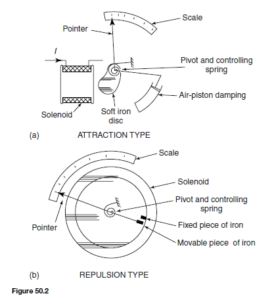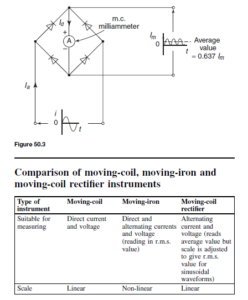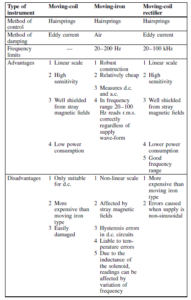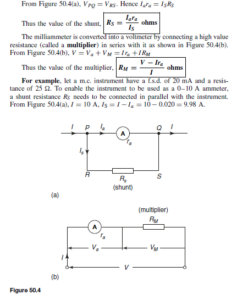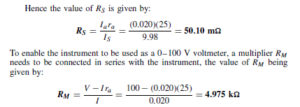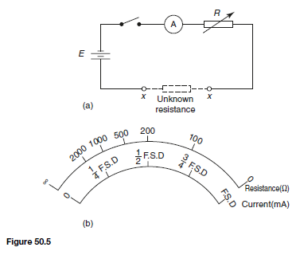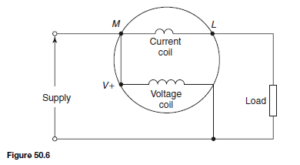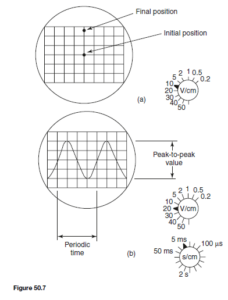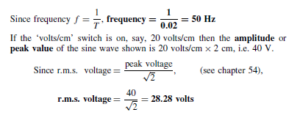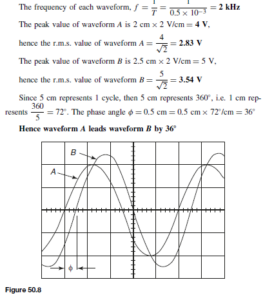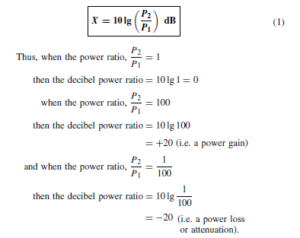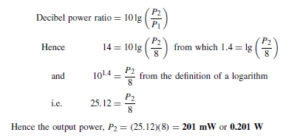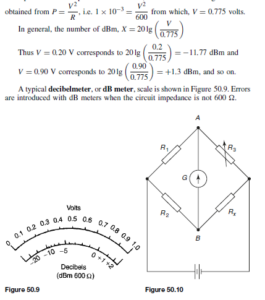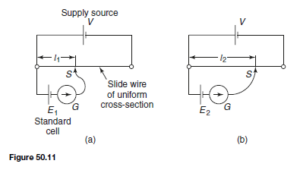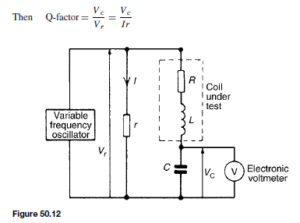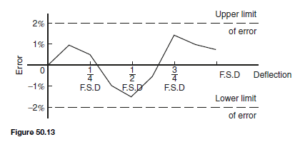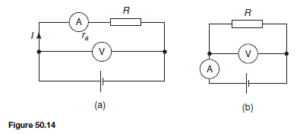Introduction
Tests and measurements are important in designing, evaluating, maintaining and servicing electrical circuits and equipment. In order to detect electrical quantities such as current, voltage, resistance or power, it is necessary to transform an electrical quantity or condition into a visible indication. This is done with the aid of instruments (or meters) that indicate the magnitude of quantities either by the position of a pointer moving over a graduated scale (called an analogue instrument) or in the form of a decimal number (called a digital instrument).
Analogue Instruments
All analogue electrical indicating instruments require three essential devices:
(a) A deflecting or operating device. A mechanical force is produced by the current or voltage which causes the pointer to deflect from its zero position.
(b) A controlling device. The controlling force acts in opposition to the deflecting force and ensures that the deflection shown on the meter is always the same for a given measured quantity. It also prevents the pointer always going to the maximum deflection. There are two main types of controlling device — spring control and gravity control.
(c) A damping device. The damping force ensures that the pointer comes to rest in its final position quickly and without undue oscillation. There are
three main types of damping used — eddy-current damping, air-friction damping and fluid-friction damping.
There are basically two types of scale — linear and non-linear.
A linear scale is shown in Figure 50.1(a), where the divisions or grad- uations are evenly spaced. The voltmeter shown has a range 0– 100 V, i.e. a full-scale deflection (f.s.d.) of 100 V. A non-linear scale is shown in Figure 50.1(b) where the scale is cramped at the beginning and the graduations are uneven throughout the range. The ammeter shown has a f.s.d. of 10 A.
Moving-iron Instrument
(a) An attraction type of moving-iron instrument is shown diagrammatically in Figure 50.2(a). When current flows in the solenoid, a pivoted soft-iron disc is attracted towards the solenoid and the movement causes a pointer to move across a scale.
(b) In the repulsion type moving-iron instrument shown diagrammatically in Figure 50.2(b), two pieces of iron are placed inside the solenoid, one being fixed, and the other attached to the spindle carrying the pointer. When current passes through the solenoid, the two pieces of iron are magnetised in the same direction and therefore repel each other. The pointer thus moves across the scale. The force moving the pointer is, in each type, proportional to I2 and because of this the direction of current does not matter. The moving-iron instrument can be used on d.c. or a.c.; the scale, however, is non-linear.
The Moving-coil Rectifier Instrument
A moving-coil instrument, which measures only d.c., may be used in con- junction with a bridge rectifier circuit as shown in Figure 50.3 to provide an indication of alternating currents and voltages (see chapter 54). The aver- age value of the full wave rectified current is 0.637 Im . However, a meter being used to measure a.c. is usually calibrated in r.m.s. values. For sinusoidal ![]() times the mean value. Rectifier instruments have scales calibrated in r.m.s. quantities and it is assumed by the manufacturer that the a.c. is sinusoidal.
times the mean value. Rectifier instruments have scales calibrated in r.m.s. quantities and it is assumed by the manufacturer that the a.c. is sinusoidal.
Shunts and Multipliers
An ammeter, which measures current, has a low resistance (ideally zero) and must be connected in series with the circuit.
A voltmeter, which measures p.d., has a high resistance (ideally infinite) and must be connected in parallel with the part of the circuit whose p.d. is required.
There is no difference between the basic instrument used to measure current and voltage since both use a milliammeter as their basic part. This is a sensitive instrument that gives f.s.d. for currents of only a few milliamperes. When an ammeter is required to measure currents of larger magnitude, a pro- portion of the current is diverted through a low-value resistance connected in parallel with the meter. Such a diverting resistor is called a shunt.
Electronic Instruments
Electronic measuring instruments have advantages over instruments such as the moving-iron or moving-coil meters, in that they have a much higher input resistance (some as high as 1000 Mˇ) and can handle a much wider range of frequency (from d.c. up to MHz).
The digital voltmeter (DVM) is one that provides a digital display of the voltage being measured. Advantages of a DVM over analogue instruments include higher accuracy and resolution, no observational or parallex errors (see later) and a very high input resistance, constant on all ranges.
A digital multimeter is a DVM with additional circuitry that makes it capable of measuring a.c. voltage, d.c. and a.c. current and resistance.
Instruments for a.c. measurements are generally calibrated with a sinusoidal alternating waveform to indicate r.m.s. values when a sinusoidal signal is applied to the instrument. Some instruments, such as the moving-iron and electro-dynamic instruments, give a true r.m.s. indication. With other instruments the indication is either scaled up from the mean value (such as with the rectified moving-coil instrument) or scaled down from the peak value.
Sometimes quantities to be measured have complex waveforms (see chapter 76), and whenever a quantity is non-sinusoidal, errors in instrument readings can occur if the instrument has been calibrated for sine waves only. Using electronic instruments can largely eliminate such waveform errors.
The Ohmmeter
An ohmmeter is an instrument for measuring electrical resistance. A simple ohmmeter circuit is shown in Figure 50.5(a). Unlike the ammeter or voltmeter, the ohmmeter circuit does not receive the energy necessary for its operation from the circuit under test. In the ohmmeter this energy is supplied by a self-contained source of voltage, such as a battery. Initially, terminals XX are short-circuited and R adjusted to give f.s.d. on the milliammeter. If current I is at a maximum value and voltage E is constant, then resistance R D E/I is at a minimum value. Thus f.s.d. on the milliammeter is made zero on the resistance scale. When terminals XX are open circuited no current flows and R(D E/O) is infinity
The milliammeter can thus be calibrated directly in ohms. A cramped (non-linear) scale results and is ‘back to front’, as shown in Figure 50.5(b). When calibrated, an unknown resistance is placed between terminals XX and its value determined from the position of the pointer on the scale. An ohmmeter designed for measuring low values of resistance is called a continuity tester. An ohmmeter designed for measuring high values of resistance (i.e. megohms) is called an insulation resistance tester (e.g. ‘Megger’)
Multimeters
Instruments are manufactured that combine a moving-coil meter with a number of shunts and series multipliers, to provide a range of readings on a single scale graduated to read current and voltage. If a battery is incorporated then resistance can also be measured. Such instruments are called multimeters or universal instruments or multirange instruments. An ‘Avometer’ is a typical example. A particular range may be selected either by the use of separate terminals or by a selector switch. Only one measurement can be performed at a time. Often such instruments can be used in a.c. as well as d.c. circuits when a rectifier is incorporated in the instrument.
Wattmeters
A wattmeter is an instrument for measuring electrical power in a circuit. Figure 50.6 shows typical connections of a wattmeter used for measuring power supplied to a load. The instrument has two coils:
(i) a current coil, which is connected in series with the load, like an ammeter, and
(ii) a voltage coil, which is connected in parallel with the load, like a volt- meter.
Instrument ‘Loading’ Effect
Some measuring instruments depend for their operation on power taken from the circuit in which measurements are being made. Depending on the ‘loading’ effect of the instrument (i.e. the current taken to enable it to operate), the prevailing circuit conditions may change.
The resistance of voltmeters may be calculated since each have a stated sensitivity (or ‘figure of merit’), often stated in ‘kˇ per volt’ of f.s.d. A voltmeter should have as high a resistance as possible (- ideally infinite). In a.c. circuits the impedance of the instrument varies with frequency and thus the loading effect of the instrument can change.
The Cathode Ray Oscilloscope
The cathode ray oscilloscope (c.r.o.) may be used in the observation of waveforms and for the measurement of voltage, current, frequency, phase and periodic time. For examining periodic waveforms the electron beam is deflected horizontally (i.e. in the X direction) by a sawtooth generator acting as a timebase. The signal to be examined is applied to the vertical deflection system (Y direction) usually after amplification.
Oscilloscopes normally have a transparent grid of 10 mm by 10 mm squares in front of the screen, called a graticule. Among the timebase controls is a ‘variable’ switch that gives the sweep speed as time per centimetre. This may be in s/cm, ms/cm or µs/cm, a large number of switch positions being available. Also on the front panel of a c.r.o. is a Y amplifier switch marked in volts per centimetre, with a large number of available switch positions.
(i) With direct voltage measurements, only the Y amplifier ‘volts/cm’ switch on the c.r.o. is used. With no voltage applied to the Y plates the position of the spot trace on the screen is noted. When a direct voltage is applied to the Y plates the new position of the spot trace is an indication of the magnitude of the voltage. For example, in Figure 50.7(a), with no voltage applied to the Y plates, the spot trace is in the centre of the screen (initial position) and then the spot trace moves 2.5 cm to the final position shown, on application of a d.c. voltage. With the ‘volts/cm’ switch on 10 volts/cm the magnitude of the direct voltage is 2.5 cm ð 10 volts/cm, i.e. 25 volts.
(ii) With alternating voltage measurements, let a sinusoidal waveform be displayed on a c.r.o. screen as shown in Figure 50.7(b). If the time/cm switch is on, say, 5 ms/cm then the periodic time T of the sinewave is 5 ms/cm ð 4 cm, i.e. 20 ms or 0.02 s
Double beam oscilloscopes are useful whenever two signals are to be compared simultaneously.
For example, for the double-beam oscilloscope displays shown in Figure 50.8, the ‘time/cm’ switch is on 100 µs/cm and the ‘volts/cm’ switch on 2 V/cm. The width of each complete cycle is 5 cm for both waveforms.
Hence the periodic time, T, of each waveform is 5 cm ð 100 µs/cm =0.5 ms
The c.r.o. demands reasonable skill in adjustment and use. However its greatest advantage is in observing the shape of a waveform — a feature not possessed by other measuring instruments.
Logarithmic Ratios
In electronic systems, the ratio of two similar quantities measured at different points in the system, are often expressed in logarithmic units. By definition, if the ratio of two powers P1 and P2 is to be expressed in decibel (dB) units then the number of decibels, X, is given by:
For example, an amplifier has a gain of 14 dB and its input power is 8 mW. Its output power is determined as follows:
Logarithmic units may also be used for voltage and current ratios. The number of decibels, X, is given by:
From equation (1), X decibels is a logarithmic ratio of two similar quantities and is not an absolute unit of measurement. It is therefore necessary to state a reference level to measure a number of decibels above or below that reference. The most widely used reference level for power is 1 mW, and when power levels are expressed in decibels, above or below the 1 mW reference level, the unit given to the new power level is dBm.
A voltmeter can be re-scaled to indicate the power level directly in decibels. The scale is generally calibrated by taking a reference level of 0 dB
when a power of 1 mW is dissipated in a 600 ˇ resistor (this being the natural impedance of a simple transmission line). The reference voltage V is then
Null Method of Measurement
A null method of measurement is a simple, accurate and widely used method which depends on an instrument reading being adjusted to read zero current only. The method assumes:
(i) if there is any deflection at all, then some current is flowing
(ii) if there is no deflection, then no current flows (i.e. a null condition).
Hence it is unnecessary for a meter sensing current flow to be calibrated when used in this way. A sensitive milliammeter or microammeter with centre zero position setting is called a galvanometer. Examples where the method is used are in the Wheatstone bridge, in the d.c. potentiometer and with a.c. bridges (see chapter 67)
Wheatstone Bridge
Figure 50.10 shows a Wheatstone bridge circuit that compares an unknown resistance Rx with others of known values, i.e. R1 and R2, which have fixed values, and R3, which is variable. R3 is varied until zero deflection is obtained on the galvanometer G. No current then flows through the meter, VA D VB , and the bridge is said to be ‘balanced’
D.c. Potentiometer
The d.c. potentiometer is a null-balance instrument used for determining values of e.m.f.’s and p.d.s. by comparison with a known e.m.f. or p.d. In Figure 50.11(a), using a standard cell of known e.m.f. E1, the slider S is moved along the slide wire until balance is obtained (i.e. the galvanometer deflection is zero), shown as length l1
The standard cell is now replaced by a cell of unknown e.m.f. E2 (see Figure 50.11(b)) and again balance is obtained (shown as l2).
A potentiometer may be arranged as a resistive two-element potential divider in which the division ratio is adjustable to give a simple variable d.c. supply. Such devices may be constructed in the form of a resistive element carrying a sliding contact that is adjusted by a rotary or linear movement of the control knob.
Q-meter
The Q-factor for a series L-C-R circuit is the voltage magnification at resonance, i.e. ![]()
The simplified circuit of a Q-meter, used for measuring Q-factor, is shown in Figure 50.12. Current from a variable frequency oscillator flowing through a very low resistance r develops a variable frequency voltage, Vr , which is applied to a series L-R-C circuit. The frequency is then varied until resonance causes voltage Vc to reach a maximum value. At resonance Vr and Vc are noted.
In a practical Q-meter, Vr is maintained constant and the electronic volt- meter can be calibrated to indicate the Q-factor directly. If a variable capacitor C is used and the oscillator is set to a given frequency, then C can be adjusted to give resonance. In this way inductance L may be calculated using
Q-meters operate at various frequencies and instruments exist with frequency ranges from 1 kHz to 50 MHz. Errors in measurement can exist with Q-meters since the coil has an effective parallel self-capacitance due to capacitance between turns. The accuracy of a Q-meter is approximately +-5%.
Measurement Errors
Errors are always introduced when using instruments to measure electrical quantities. The errors most likely to occur in measurements are those due to:
(i) the limitations of the instrument
(ii) the operator
(iii) the instrument disturbing the circuit
(i) Errors in the limitations of the instrument
The calibration accuracy of an instrument depends on the precision with which it is constructed. Every instrument has a margin of error that is expressed as a percentage of the instruments full scale deflection. For example, industrial grade instruments have an accuracy of š2% of f.s.d. Thus if a voltmeter has a f.s.d. of 100 V and it indicates 40 V say, then the actual voltage may be anywhere between 40 š (2% of 100), or 40 š 2, i.e. between 38 V and 42 V. When an instrument is calibrated, it is compared against a standard instrument and a graph is drawn of ‘error’ against ‘meter deflection’. A typical graph is shown in Figure 50.13 where it is seen that the accuracy varies over the scale length. Thus, a meter with a š2% f.s.d. accuracy would tend to have an accuracy which is much better than š2% f.s.d. over much of the range.
(ii) Errors by the operator
It is easy for an operator to misread an instrument. With linear scales the values of the sub-divisions are reasonably easy to determine; non-linear scale graduations are more difficult to estimate. Also, scales differ from instrument to instrument and some meters have more than one scale (as with multimeters) and mistakes in reading indications are easily made. When reading a meter scale it should be viewed from an angle perpendicular to the surface of the scale at the location of the pointer; a meter scale should not be viewed ‘at an angle’.
(iii) Errors due to the instrument disturbing the circuit
Any instrument connected into a circuit will affect that circuit to some extent. Meters require some power to operate, but provided this power is small com- pared with the power in the measured circuit, then little error will result. Incorrect positioning of instruments in a circuit can be a source of errors. For example, let a resistance be measured by the voltmeter-ammeter method as shown in Figure 50.14. Assuming ‘perfect’ instruments, the resistance should be given by the voltmeter reading divided by the ammeter reading (i.e. R D V/I). However, in Figure 50.14(a), V/I D R C ra and in Figure 50.14(b) the current through the ammeter is that through the resistor plus that through the voltmeter. Hence the voltmeter reading divided by the ammeter reading will not give the true value of the resistance R for either method of connection.



